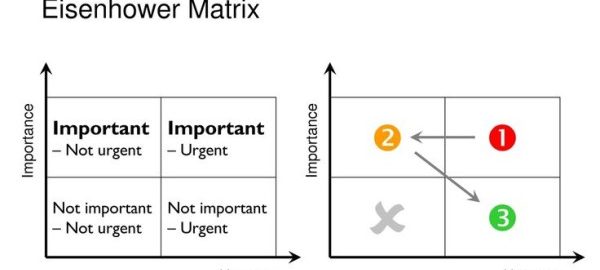It’s 9am and you’re at the office.
You’ve already brewed your coffee, got your entire day planned out, and you’re off to the races to get things done.
An hour flies by. You’ve managed to maintain your focus and you tell yourself, “this is going to be a great day.” You look around the room, and decide that you could go for a 5-minute walking break.
But when you return to your desk, you find a stack of unexpected work from your boss, which wasn’t on your agenda. As you begin to focus to get things done again, your colleague barges in asking where you want to go for lunch.
You now realize it’s 11:30AM, and you only have half an hour left before your lunch meeting. Then your Facebook notification suddenly pops up on your phone, and you spend the next half an hour scrolling through your Newsfeed.
Before you know it, by the time you return from lunch, it’s already 2PM and your day is nearly over.
Has this ever happened to you? If so, you’re not alone.
The Cost Of Distraction
It turns out that 95% of workers are distracted during their workday.
Gloria Mark, a professor at the University of California at Irvine, found that the technology workers she studied would make it, on average, only 11 minutes into a project before being distracted. And here’s the punchline.
It takes an average of 23 minutes and 15 seconds to get back your flow back, upon being distracted.
Now, we can either look at this as the glass half empty, meaning that we can focus on the amount of time we have wasted during our day. Or we can look at this as the glass half full, by focusing on the amount of time we can win back, and the potential to get things done.
All we need are productivity tips and principles that can help guide us in the right direction. These are the same productivity principles that global leaders, world-class entrepreneurs, and professional athletes use on a daily basis to help them get an edge on life and get things done.
Let’s start with…
1. Eating The Frog
You may have already heard the infamous business adage, “eat that frog!”

The basic idea here is that if you do the hardest or worst thing on your plate first thing in the morning, the rest of your day will be a walk in the park.
So if the hardest task on your list is writing a blog post (as it is for me), then that’s exactly what you should do first before you move on to another task.
In Brian Tracy’s book, “Eat That Frog!”, he outlined the 4 simple categories you can organize your tasks:
Things you don’t want to do, and actually don’t need to do.
Things you don’t want to do, but actually need to do.
Things you want to do and actually need to do.
Things you want to do, but actually don’t need to do.
If you’re wondering what the “frog” is in your daily to-do list, it’s the tasks that fall under: Things you don’t want to do, but actually need to do.
2. Pareto Principle (Law Of 80/20)
We’ve talked extensively about how we use the Pareto Principle at our company, but we embrace it so much that it’s worth exploring again here.
To give you some quick history background, the Pareto Principle (also known as law of 80/20) was originally introduced by an Italian Economist by the name of Vilfredo Pareto. Vilfredo’s breakthrough came when he realized that 80% of the land (and wealth) in Italy was only owned by 20% of the wealthy.

This distribution quickly expanded and was applied into the world of business, software, time management, and many more industries.
To show you what we mean, if you were to take a look at your own life right now, you would likely find that:
- 80% of your expenses come from only 20% of things (i.e. rent/mortgage, transportation, etc.)
- 80% of your sales come from only 20% of your customers/products
- 80% of your happiness comes from only 20% of the people around you (i.e. family, friends)

The point here is that very few things actually matter in our daily activities. Most of us get hung up on the “Expectations” side of time management, hoping that every input will have an equivalent amount of output. When in “Reality”, only 20% of our most important activities will deliver 80% of our desired results.
It’s also why we had to say “no” to almost every other growth strategy that was thrown our way while trying to get our first 100 customers, in order to ensure we’re focusing on the 20% that will deliver 80% of results.
3. Parkinson’s Law
Think about the last time you were under pressure to get things done.
Maybe you were given a whole month — to study for that exam, to finish a work project — and now you’re down to one week. If you’re like most people, you probably got more done in one week than the previous three weeks given to you. You experienced what’s known as Parkinson’s Law.
The definition of Parkinson’s Law is: “work expands so as to fill the time available for its completion.”
It basically means that if we give ourselves three hours to complete a task that would normally take ten minutes, we’ll find a way somehow to use up all of those three hours.

To apply Parkinson’s Law to your advantage, here are a few practical suggestions:
- Work in short sprints (30-90 minutes — no longer). I personally use the Pomodoro Timer, which allows me to set up a 25-minute timer to complete one task. Then I take a 5-minute break to complete the task or move on. More about the impact of the Pomodoro technique here.
- Put your computer charger away, and work without it. For some reason, this forces me to get things done before the battery runs out, and is also a great reminder to take a break while it’s charging.
- Segment similar work activities and tasks into your day. For example, I do all of my creative work during the morning: blogging, product planning, brainstorming, etc. And I segment all of my communication in the later afternoon: emails, phone calls, team meetings, etc.
4. Eisenhower Matrix
Do you constantly find yourself putting out fires in your business or work that are “urgent”, only to find out that you didn’t do anything truly “important” during your day?
You may need to apply the Eisenhower Matrix to make better decisions in your day.

Take a list of all the tasks that you need to do today or this week, and place it into one of these categories. As shown in the diagram above, we should prioritize our tasks from 1 to 3, and ignoring 4 (Not Urgent and Not Important).
Here’s some examples of these in real-life, and the follow-up actions you should take:
1. Urgent and Important – the kitchen catching fire, a deadline to submit tax reports, a baby crying (Do it immediately)
2. Not Urgent and Important – doing exercises, long term planning, working on a project (Decide when you’ll do it)
3. Urgent and Not Important – various interruptions, facebook updates (not that Eisenhower used Facebook at his time), dealing with annoying people (Delegate to someone else)
4. Not Urgent and Not Important – activities that just waste time, procrastination, the wikipedia time-sucking hole, etc. (Do it later)
The takeaway here is that we should cherish our time, as it’s our most valuable commodity. One simple exercise you can try is to take whatever you’re making per hour (i.e. your annual salary/2,000 hours), and multiply it by 10x. If you’re making $ 20/hour, now you’re making $ 200/hour.
Now when you look back at your daily tasks, ask yourself: is this worth your time? Or is it better to delegate this to someone else or put it off until later, when you’re more free. The goal is to spend as much of your time on tasks that will give you the greatest return for your valuable time, instead of miscellaneous activities like answering phone calls, emails, or running errands.
“What is important is seldom urgent and what is urgent is seldom important.”
5. The 2-Minute Rule
Bestselling author and time management consultant, David Allen, shares that the 2-minute rule is one of the most underestimated productivity tips out there.
According to Allen, “A lot of people procrastinate because they don’t know what their next action should be. When you actually make the determination of what to do next, when you say, ‘Oh wait a minute, you know, I could do that pretty fast,’ that’s when you can get things done.”
I’ve certainly been guilty of this myself. It’s a natural tendency to plan, organize, and try to estimate the amount of time a task will take, when it could have been finished by the time I was done planning.
Allen recommends that we make a list of 2-minute tasks that we can complete throughout the day, whenever we find idle time or have that moment of, “what should I do next?” It could be following up with a client, calling your partner, booking that plane ticket, etc.
You can think of these 2-minute tasks as a way to transition into your next big task for the day, without losing momentum and flow. As we’ve shared with you in the beginning of this article, the cost of distraction is high and mighty.
Business & Finance Articles on Business 2 Community(118)
Report Post








